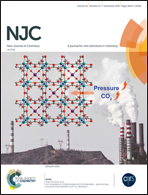Synthesis, growth and characterization of a new acentric 4-[4-(4-dimethylamino-phenyl)buta-1,3-dienyl]-1-methyl pyridinium p-chlorobenzenesulfonate dihydrate crystal for nonlinear optical applications†
Abstract
A new chromophore 4-[4-(4-dimethylamino-phenyl) buta-1,3-dienyl]-1-methyl pyridinium p-chlorobenzenesulfonate (DACSC) with extended π-conjugation was synthesized. Nucleation and solubility studies were performed to identify a suitable solvent system for the material growth. 4-[4-(4-Dimethylamino-phenyl) buta-1,3-dienyl]-1-methyl pyridinium p-chlorobenzenesulfonate dihydrate (DACSC·2H2O) crystals with non-centrosymmetric space group were developed from the mixed solvent system. The grown crystal was characterized by CHN, NMR, single crystal XRD, UV and TG-DTA techniques, and the results were reported for the first time. The effect of hydrogen bonds on molecular packing to obtain perfectly aligned cations was investigated. Second harmonic generation efficiency of the compound was measured by powder test, and density functional theory calculations were carried out to compare the nonlinear optical properties of DACSC at the molecular level.
![Graphical abstract: Synthesis, growth and characterization of a new acentric 4-[4-(4-dimethylamino-phenyl)buta-1,3-dienyl]-1-methyl pyridinium p-chlorobenzenesulfonate dihydrate crystal for nonlinear optical applications](/en/Image/Get?imageInfo.ImageType=GA&imageInfo.ImageIdentifier.ManuscriptID=C8NJ03261K&imageInfo.ImageIdentifier.Year=2018)


 Please wait while we load your content...
Please wait while we load your content...